Viewed from the air, the landscape of Brazil resembles an unquiet, green sea. The innumerable ridges of the foothills crest like waves with the foamy mist floating between the swells. I look ahead at the mountains — rows of giants bathing on their backs in a pool of clouds, their craggy noses and chins emerging from the mist, like synchronized swimmers.
The early morning drive into Rio de Janeiro descends from splendid views to the splintered existence of 14 million people crowded between the mountains and the sea. Our taxi passes neighborhoods of derelict apartment buildings that lean over each other like crooked teeth, the electrical wires jerry rigged among them like orthodontia. Without basic services, each building is capped with a blue plastic barrel to harvest rainwater. Laundry hangs out of every window, and discarded, broken junk litters the streets.
Our driver taps his brakes to avoid hitting one of the numerous motorcycles weaving between the cars. Again and again, wide-hipped women in spandex straddling mopeds pass us, driven wildly by men beeping their horns in a constant accompaniment to their motors’ roar — a music meant to distract death another day.
In the back of my taxi, I sit between my grown children and listen to Google Translate pronounce “Bom dia!” and “Feliz Natal” — Good morning! Merry Christmas! — as my eye catches an open fire beneath a bridge where men bathe in the runoff from a street overhead. Amid trash on discarded mattresses, others catch a last few moments’ sleep — while the even less fortunate lie precariously on the bridge’s trestles. I am struck anew by the meaning of O Come, O Come, Immanuel and the sacrifice of joining this deprivation — to be God with us.
The road dives into a tunnel, shortcutting that train of thought, and opens onto the beach-front Rio where bodies parade in the summer sun and Cristo Redentor stands triumphant over the scene. Our hotel overlooks Copacabana Beach where the spectacular, sunbathing mountains are scantily clad in white mist. We’re in time for breakfast where the waiters are amused by my attempts at Portuguese and humble me with their multilinguality.
On our way to the Sugarloaf Mountain cable car, we take a midmorning stroll on Copacabana Beach. There is something more to be understood about a culture so unafraid of cellulite. With Presbyterian modesty, we walk fully clothed past women in string bikinis with back-fat draping, tubby stomachs protruding, and fully-exposed haunches jiggling — this is not the Sports Illustrated Rio of one’s expectation but rather that nightmare in which you forgot your clothes. Even so, we receive everyone’s stares and head-turns as if we were the naked ones walking down a street in the Bible Belt. Peddlers selling whole grilled shrimp, string bikinis, beers — and ingenious cloth bags that transform into wraps — pause their sales pitches when they see us, perhaps awed by this visitation from another world. My children are exquisitely uncomfortable — my 14-year-old daughter because I am never deterred by embarrassment and my 15-year-old son for the obvious reasons — so my husband and I force them to pose for only two pictures and follow them off the beach.
The fabled lines and two hour waits at the Sugarloaf Mountain cable cars are mythical — we purchase tickets immediately and walk onto the sky tram. As advertised, the views are spectacular. The water dashing against rocks below us contrasts with the majestic peaks rising from placid waters in the mid-distance.
Upon arrival at the top, I’m a tourist happily trapped and purchase a coconut with a straw for a refreshing drink. We have timed our visit to catch the magnificent sunset over the mountains — but, sadly, a cloud arrives and outstays us. At a small, open-air bar in the mountaintop rainforest, we dine while mist drifts across the table. It collects in droplets in our hair and soaks our napkins, though nothing can dampen our spirits. We are delighted with every novelty as the birds screech in the jungle around us.
At the midway point in our descent (the cable car stops at an intermediary mountain below the clouds), we capture the sunset, after all, radiant between the peaks. Our first day is full of wonder.
A day closer to Christmas, we awaken to another breakfast buffet with a Brazilian Christmas delicacy that tastes like French toast; tomatoes stewed in rosemary; fresh papaya, mango, pineapple, and guava (whose seeds I don’t know what to do with); as well as meats, cheeses, and pastries. We depart well fortified for our next destination: Cristo Rendentor atop Corcovado mountain. The internet is full of helpful suggestions for which bus to catch to the foot of the mountain, which would be more authentic, I’m sure — but an Uber costs only $2, so we do that.
Those more fit than we can climb the mountain. For those full of breakfast, the best way to reach the statue is via cog train through the jungle. We purchase our tickets from a small colonial depot (no line again) and allow enough time to visit a nearby 19th century plaza, its surrounding colonial buildings decorated with blue Portuguese tile. It is a walk back in time, separated from the busy road by a stone bridge over a creek. We stay for half an hour, gazing at the jungle flowers and overhanging banyan trees, the bright yellow paint on one plaster facade and the wrought iron lamp posts from another era. Apart from the restored square and a few other reclaimed buildings, this area — carved from the jungle by the Portuguese — is left to ruin, the banyan tree vines draping over 150-year-old cast iron fences and crumbling facades. It is a sobering reminder that no creation of man endures.
On our ride to the top of Corcovado, the train climbs at a 20º gradient and pauses halfway at a lonely platform where a single Black man carrying a cloth sack disembarks and strides into the jungle. There’s a whole novel to be written about that. Further up the track, a welcome center has its own stop with a museum we do not visit, and the train clatters upwards past a window where a woman works at a computer in jarring contrast to our surroundings.
At the top, we are surprised to discover that the resourceful Cariocas have created a tourist haven with functioning bathrooms, a restaurant, countless shops selling Christ the Redeemer in miniature, and escalators to ascend visitors to Christ’s feet. No clouds have followed us today, and we have 360º views of Rio and the world’s largest urban forest. Cristo Redentor itself is truly impressive, its entire surface covered with a tiny soapstone mosaic, including the toes, each of which is the size of a human. We take the requisite photo — my husband lying on the ground for proper perspective — enjoy a Coke with the view, buy a T-shirt for my son, and return via cog train. The descent is disconcertingly faster than the ascent.
Before returning to change for dinner, we Uber to Leblon, the richest area of Rio, to enjoy a drink and watch the Cariocas in their colorful sundresses. As we walk into the cafe, we have an encounter that repeats itself nine or ten times during our week in South America: a well-dressed diner approaches my husband — who loves photography and has been toting his large-lensed camera wherever we go — and begs him in perfect English not to carry his camera in public. He assures my husband that Rio is very dangerous and that his reckless behavior will invite violence, bad for everyone. The man is quite friendly and also advises us not to visit Copacabana — it is so unsafe, he never goes there. We thank him and do not tell him the location of our hotel. It occurs to us on our walk back that we have not felt unsafe in Rio — perhaps my 6’7” son acts as a deterrent? My 6’ daughter doesn’t look particularly vulnerable either.
Dinner is at a restaurant among the trees in the mountains around Rio. Our Uber driver doesn’t speak any English, and my Portuguese is limited to the aforementioned phrases and “Me desculpe, eu nao falo portugues” — I’m sorry, I don’t speak Portuguese — which my musician’s ear gives enough of a correct accent that he doesn’t believe me. When we arrive at a fork in the road, a decision must apparently be made, and my deceptive accent makes me the recipient of a stream of Portuguese as the driver points to the right where I see a tunnel and a gathering of unhappy-looking people. I repeat my stock phrase, and he decides to take the left fork. In the passenger seat, my husband thinks to utilize Google Translate to ask what that was about, and we discover that the right fork is a more direct route under the mountain, but that the criminals who operate there make the drive dangerous. Via Google Translate, we thank the driver and agree that it is better to be late to dinner.
Our driver’s car is nearly shaken to pieces on the cobblestones near our destination — I’m not sure he knew what was in store when he accepted our ride-request — but we arrive safely, and the meal at Aprazivel is outstanding. I moan my way through the best roast duck I’ve ever tasted and will never forget the flourless chocolate cake with candied cashew crust — not too dark, not too sweet: perfection. At the end of the meal, we are surprised when an Uber driver accepts our remote fare. He arrives in an SUV and is not afraid of cobblestones or criminals — we return to the hotel in half the time.
Christmas Eve is our third beautiful day with no rain. I don my red gift-bow earrings and jingle bell necklace and prepare to celebrate the season with the famously festive Cariocas. Undeterred by the strange absence of Christmas lights on the streets or displays in the stores, I joyfully wish every sales person, ticket taker, waiter, and taxi driver “Feliz Natal!” and note their surprise, as if they’d forgotten it was Christmas. Some are charmed, others bemused by my joy, and absolutely no one wishes us a Feliz Natal unless prompted — many not even then. I wish I spoke their language so I could understand this seeming lack of interest in one of the most hopeful days of the year.
My family takes a Christmas Eve walk on Ipanema Beach where we climb out to the rocky point and sit facing the ocean, singing Christmas carols. We are startled when an enterprising young man in dirty clothes clambers down the rocks toward us balancing a tray with a dozen cold drinks to sell. He is full of joie de vivre, and I smile, delivering my one line of Portuguese as he tries to hawk his wares. He repeats himself in Spanish — alas, no lo comprendo. We communicate well enough to exchange names and fist bumps. Phillipe’s expressive pointing into the mountain behind us tells me he hails from the overlooking favela, one Portuguese word I do recognize that means “slum.” In an overflow of hospitality, he extends towards me a straw-full of one of his drinks to taste for free. Rather than open my mouth to this mystery concoction, I awkwardly hold out my hand, and he releases the purple fluid into my palm, excitedly waiting for me to taste it. As my teenagers watch in alarm, I sip the sickly sweet, alcohol-laced drink, praying that I don’t get sick from wherever he got these ingredients, and thank him sincerely for his kindness. I wish him a “Feliz Natal,” and he — delighted by the novelty — wishes me one, too, and moves on to less risk-averse customers.
We meander back to the Ipanema beachfront where my daughter buys gifts for her classmates from one of the many artists lining the boardwalk – among them, a man named Manuel selling a spectacular display of hand-made beaded jewelry. He returns my Portuguese Christmas wishes with a “Feliz NAVIDAD!” — Manuel is Colombian. As his beautiful wife and baby watch from the shade, we purchase several pairs of earrings, and he gives us his card — which I have misplaced but will post later if I find it.
As evening approaches, we have a drink at a beachside cafe and anticipate our Christmas Eve plans. My internet research before traveling revealed that everything will be open as usual on Christmas Day and that Cariocas celebrate the season on Christmas Eve — when all businesses close early, no restaurant will be open, and everyone goes home to celebrate with family. I reasoned that hotel restaurants would have to be open for their guests and had made reservations accordingly.
Our family’s traditional Christmas Eve in Atlanta begins with a church service, continues with dinner at Waffle House and ends with a late showing of It’s a Wonderful Life, always screening somewhere. In a fun departure, we celebrate Christmas Eve this year at the Copacabana Palace Hotel, scene of mid-century splendor and celebrity sightings. Maintaining the grandiosity more than half a century later on a beach-front that its own wealthy residents refuse to visit must be a challenge, but the hotel provides a spread of the most beautifully presented food I’ve ever seen. We give thanks before the meal and enjoy the feast from our corner banquette in the elegant room, festooned with jungle flowers.
Observing the other diners in their gorgeous attire, I wonder if anyone else is reflecting on the first Christmas Eve when there was no room at the inn and only straw for a bed. The Gospel writer Luke makes no mention of the food they ate, but I imagine a purchased loaf of bread and milk from a cow in the barn (no mention of animals either, but something must have eaten from that manger). Jesus was born into a world more like Phillipe’s favela than this Copacabana Palace of plenty. Come to think of it, Jesus left His palace of plenty in Heaven to be born into our hungry world — to invite us to feast with Him in eternity. It’s a pale reflection of that heavenly feast-to-come, but our beautiful Christmas Eve celebration succeeds in turning my heart to the Giver of all good things.
We leave on Christmas Day for Buenos Aires, after which we’ll embark on a cruise to Antarctica, the reason for this South American odyssey. None of the four of us are beach people — and Rio is nothing if not a beach culture — so we’d almost decided to give it a pass. But at the end of three days in which we saw only the highlights, I am moved by this glimpse of a magnificent, filthy, glorious, poverty-stricken city at Christmas, yearning for the hope that Immanuel — God-with-us — brings.

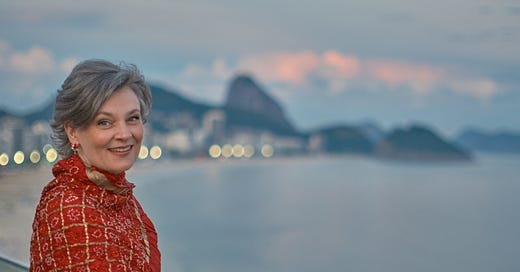

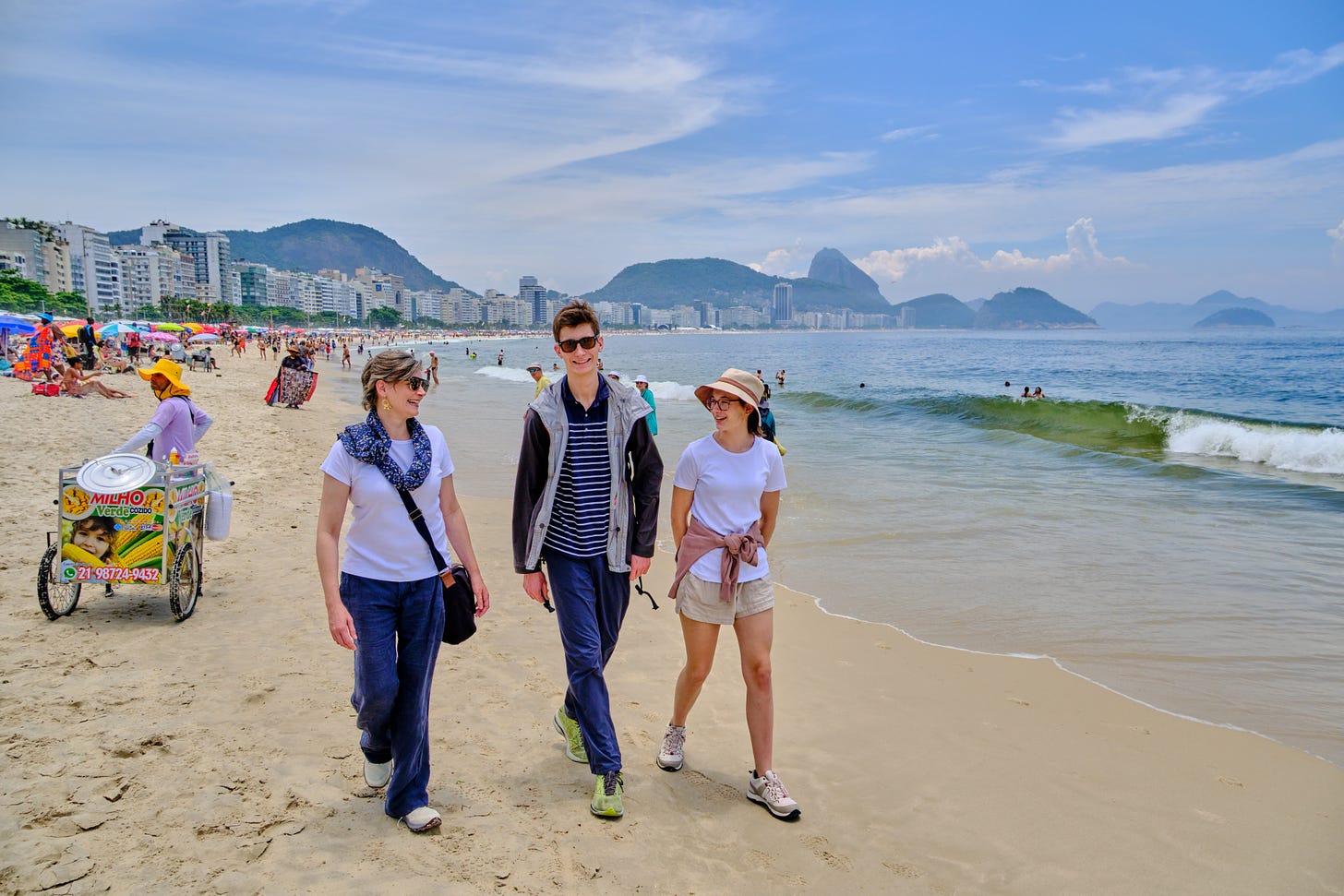
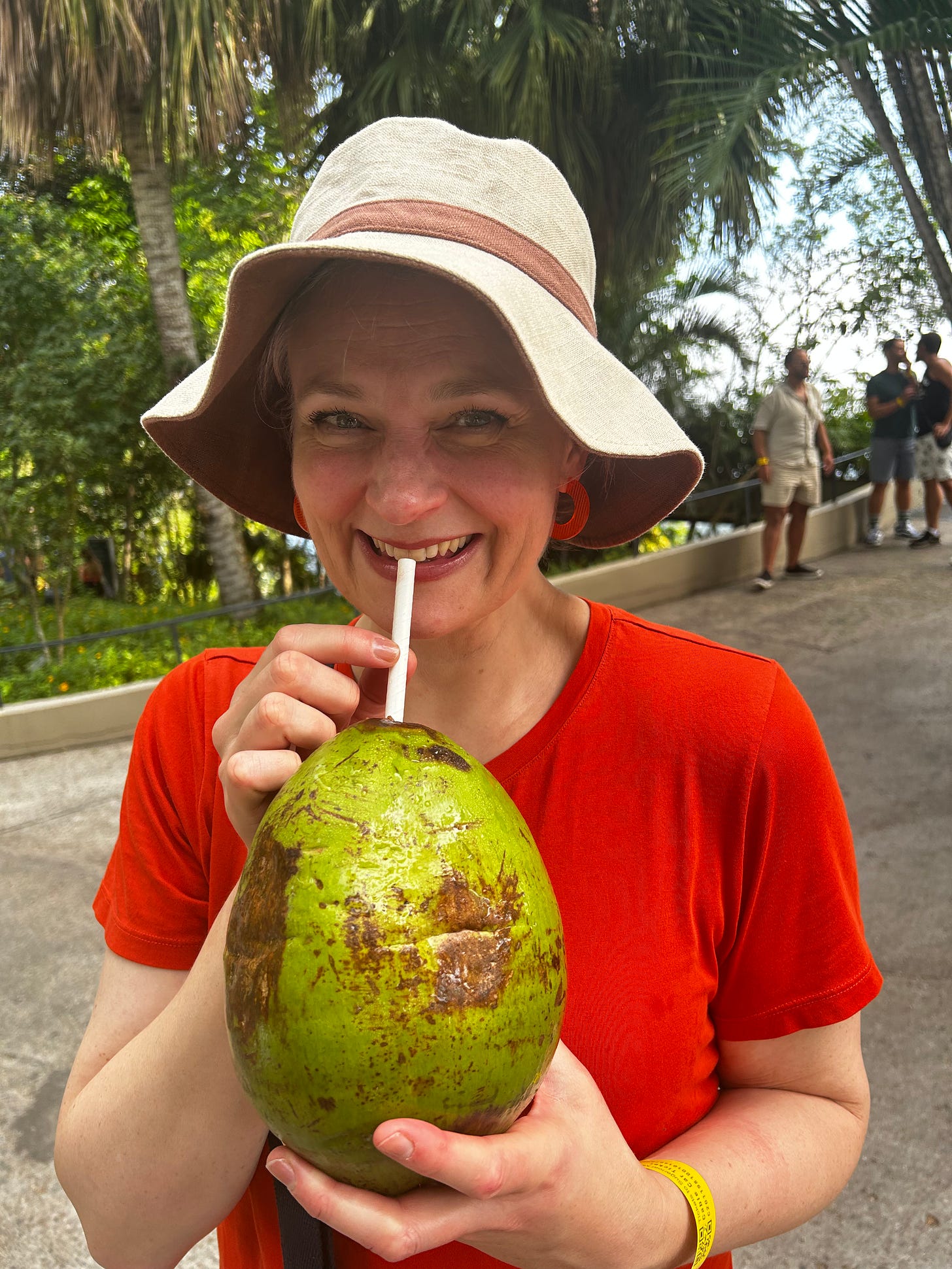
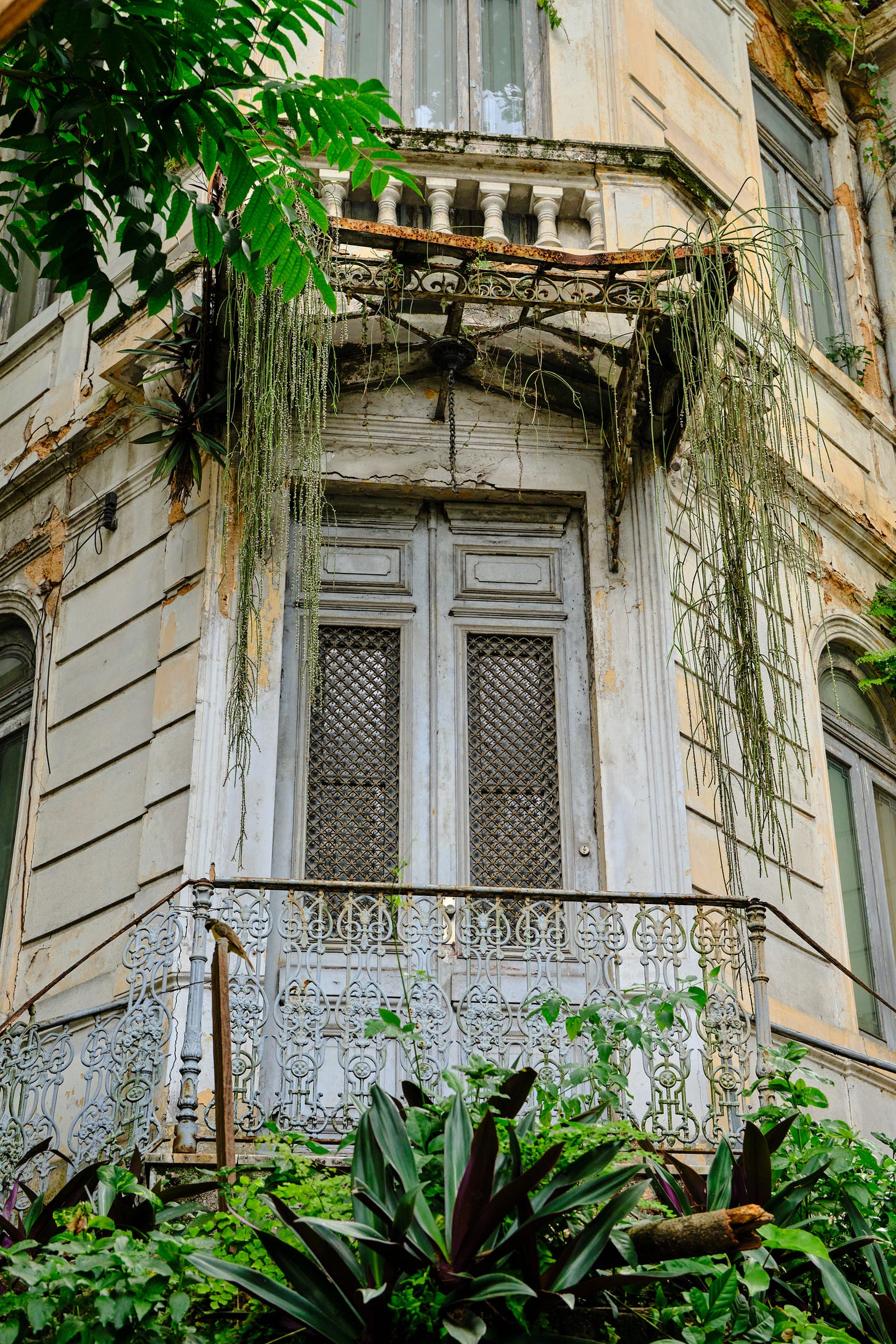
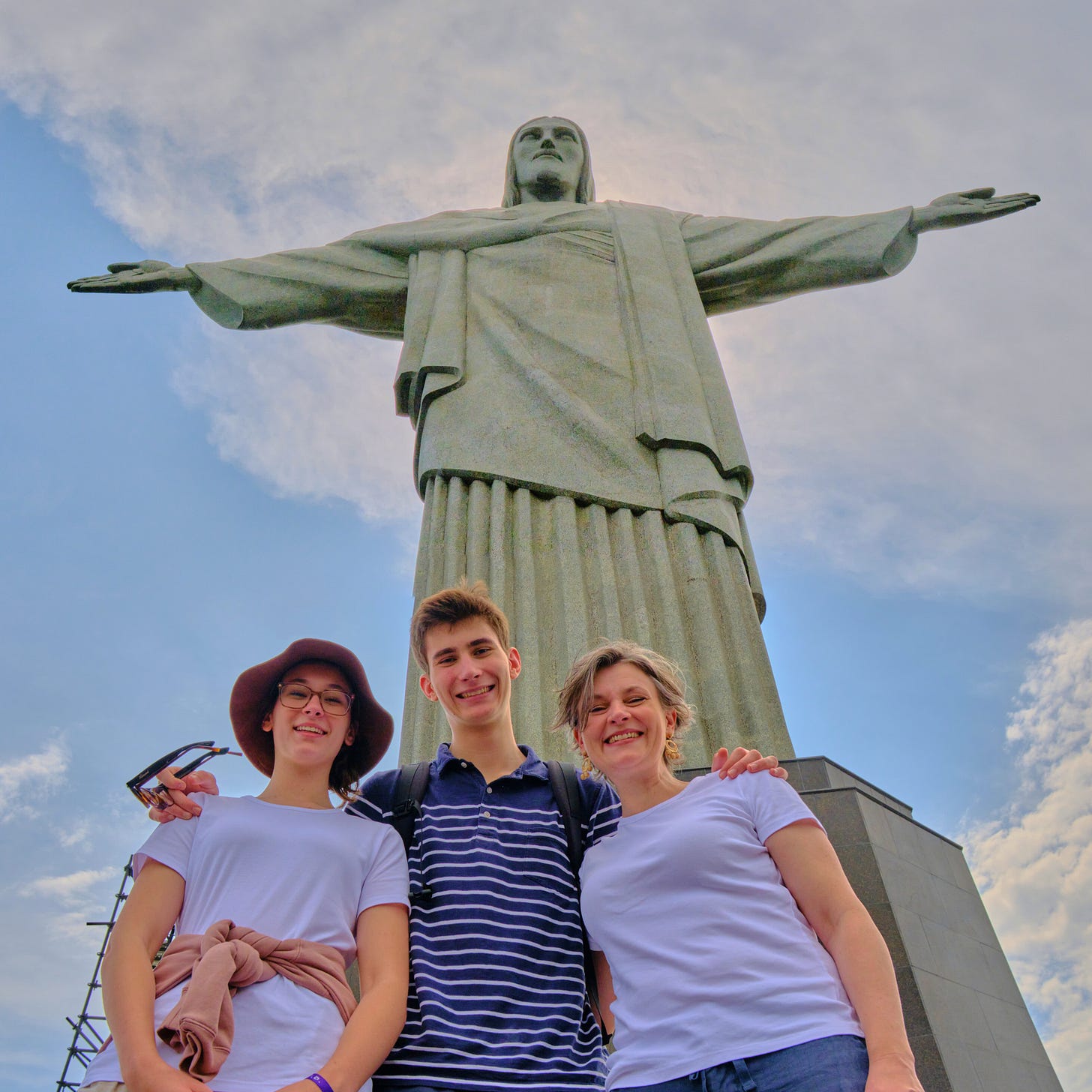
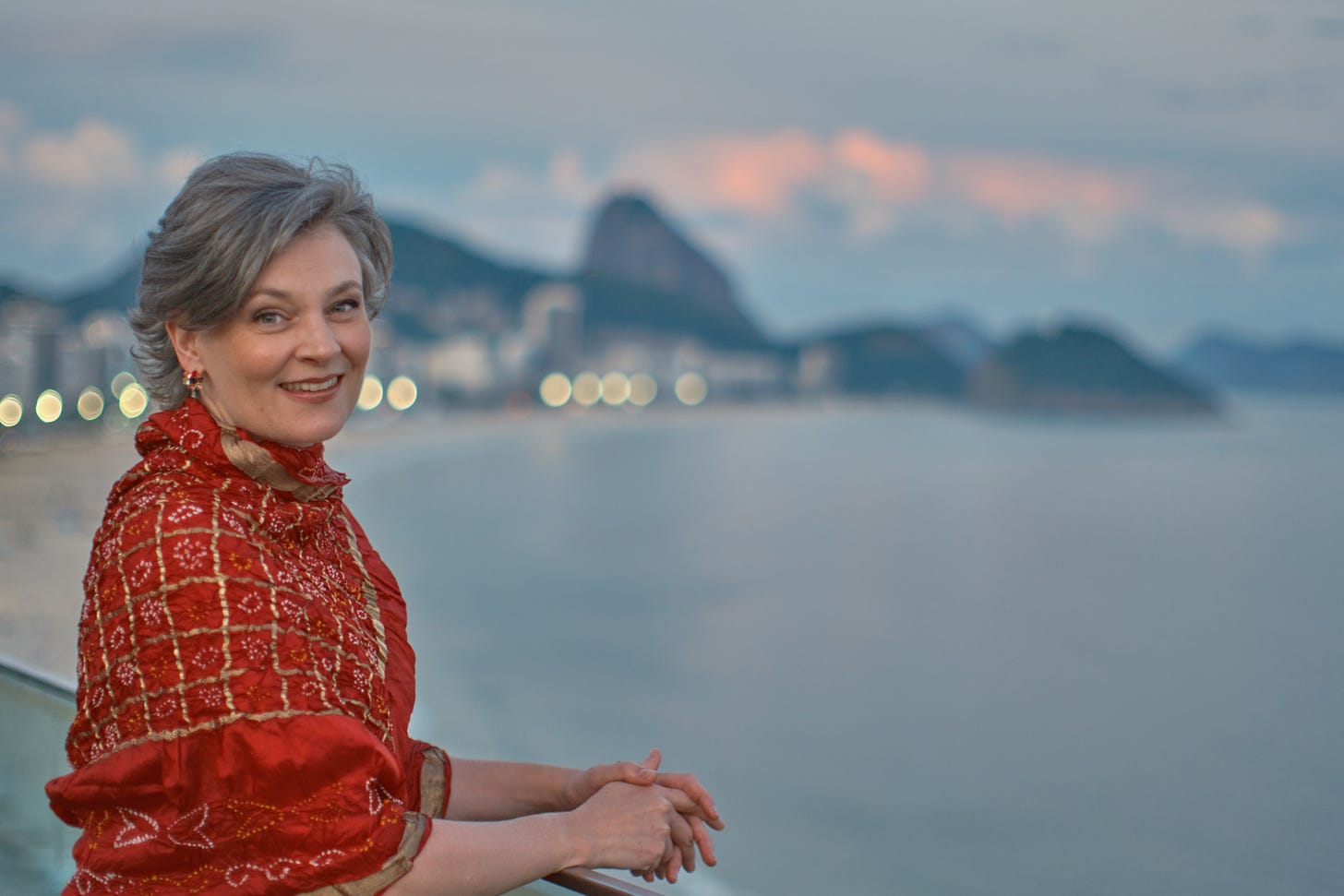
Thanks for reading, friends! I'm so grateful for your encouragement!
I couldn’t love this any more— I totally felt like I was there along with you all on this amazing adventure!! So excited to read more and your fabulous descriptions!!!